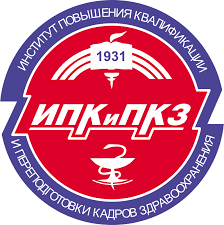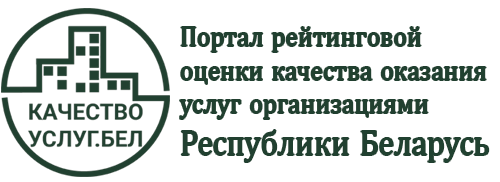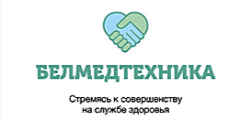A Historical Overview of N. N. Alexandrov National Cancer Centre
N. N. Alexandrov National Cancer Centre is the legal successor of the Belarusian Research Institute of Oncology and Medical Radiology (Bel RI OMR) founded in the compliance with the Resolution of the BSSR Council of Ministers “On the Issue of Enhancing Cancer Research Studies” of May 25, 1959.
The founder of the new oncological institution was Nikolai Nikolayevich Alexandrov, an outstanding surgeon, scientist and organizer of the medical science.
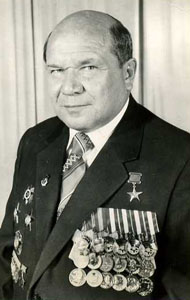
Alexandrov
Nikolai Nikolaevich
MD DSc, Professor, Corresponding Member of the USSR Academy of Medical Sciences, Hero of Socialist Labour, BSSR State Prize Winner, Chairman of the Belarusian Scientific Society of Oncologists, member of the Boards of All-Union Scientific Societies of Oncologists, Roentgenologists and Radiologists, member of the Scientific Council for the issue “Malignant neoplasms” at the Presidium of the USSR AMS. Hero of Socialists Labour (1977).
Nikolai Nikolayevich shared his experience in cancer care organization in Byelorussia at various national medical forums, at meetings with participants from socialist countries, and during his business trips to the USA, GDR, Austria, Switzerland and the Netherlands.
Since 1974, he was a WHO expert in international co-operation in anticancer studies. This experience was reflected in the 1980 monograph “Cancer Control in the Member Countries of the Council for Mutual Economic Aid” created with Nikolai Nikolayevich’s participation.
~ 1960 ~
September 3, 1960 is regarded as the birth date of the Bel RI OMR – the day when the first Institute order was signed by its first Director N. N. Alexandrov, the founder of the Institute, was heading it for 21 years, making it one of foremost cancer institutes both in the home country and far abroad. In the course of those years, a unique scientific school was established, numerous inventions were made, unquestionable accomplishments were achieved in addressing the issues faced by the RI OMR: construction of the Institute, organization of specialized cancer care for the population of the Republic, development of targeted programmed planning of scientific studies, creation of novel, highly efficient methods of diagnosis and treatment for cancer patients.
The inauguration of the Institute gave an impetus to and became an important landmark in the development of the oncological science and clinical oncology in Belarus. Initially, the new institute was allocated several premises in the former National Cancer Dispensary and in the surgical in-patient department of Minsk First Clinical Hospital.
The first staff workers of the Institute, 1961
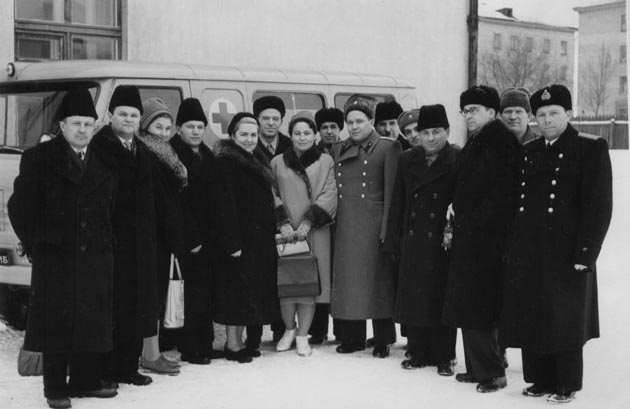
One of the main merits of N. N. Alexandrov in the formation and development of the new institute was the selection of research supervisors. They were T. T. Poddubnaya, T. A. Pantyushenko, L. S. Sukhovatykh, G. D. Golub, L.Ya. Shuster, E. V. Trushnikova, I. G. Zhakov, G. A. Berlov, Z. M. Gutman, S. Z. Fradkin, B. D. Shitikov, I. P. Serzhanin, V. K. Kukhta, A. V. Vacker.
~ 1962 ~
Planning and conducting scientific studies commenced since 1962. Original adrenal operations for late breast cancer (N. N. Alexandrov, T. A. Pantyushenko), new combination treatment modalities incorporating surgical interventions with radiation exposure (the use of radioactive colloid gold) for the treatment of patients with stomach, lung, large intestine tumors (L. S. Sukhovatykh), scruting of hyperthermia as a curative factor in oncology – all this gained prestige for the young Belarusian school of oncologists virtually established by N. N. Alexandrov.
~ 1965 ~
The termination of the first phase of the new institute construction with setting up a 450-bed clinic made it possible to specialize clinical divisions and form research departments.
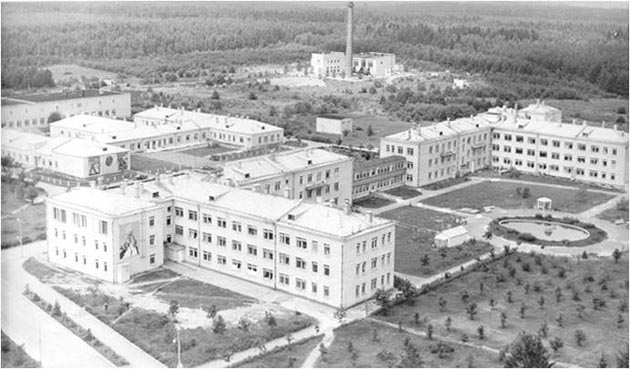
All kinds of tumor management (surgery, radiotherapy, chemotherapy) began to be applied at the Institute. The foundations of abdominal (L. S. Sukhovatykh, G. V. Egorova) and thoracic (I. A. Golubovich, L. S. Yaskevich) surgery were laid down in the operative practice.
The domestic school of mammologic oncologists (T. T. Poddubnaya, T. A. Pantyushenko), gynecologic oncologists (E. V. Trushnikova, E. E. Vishnevskaya, ENT oncologists (A. V. Vacker)) and radiation oncologists (I. G. Zhakov, G. V. Muravskaya) was arising. Investigation of new antitumor drugs and various treatment regimens was started at the Department of Experimental and Clinical Chemotherapy (I. P. Serzhanin).
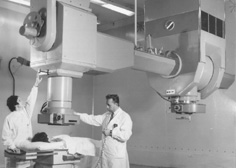
In 1960-1970s, multipurpose clinicobiochemical and hormonal laboratories (V. K. Kuhta, E. F. Konoplya, V. I. Prokhorova) and the laboratory of radionuclide diagnosis with open isotope block (B. D. Shitikov, A. B. Sinitsyn) were organized.
The diagnostic radiology service (G. D. Golub) provided training of national specialists in cancer diagnosis. The cancer pathology service (G. A. Berlov, G. N. Muravyov, A. V. Furmanchuk) was arising.
The centre of clinical cytology (L. B. Klyukina) providing training for specialists of the whole region began its functioning at the Institute. The comprehensive approach was applied using the methods of cytology, histology, histochemistry, and morphometry.
The staff of the Cancer Institute (a doctors’ meeting, 1966).
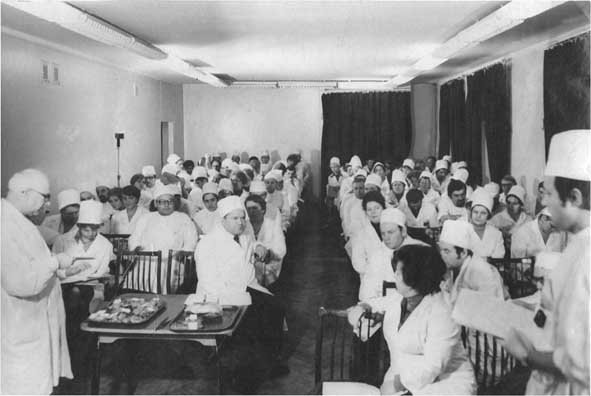
~ 1974 ~
In 1974 the RI OMR achieved the status of a first-grade institution and became one of the major cancer centres of the country, and the leading one in the Soviet Union for certain issues.
In 1977 and 1978, according to the results of the ALL-Union inspection of research institutions, the Institute was awarded the Challenge Red Banner of the USSR Public Health Ministry and the Central Committee of the Medical Workers Trade Union, and N. N. Alexandrov, the first Director of the Institute, was conferred the honorary title of a Hero of Socialist Labour.
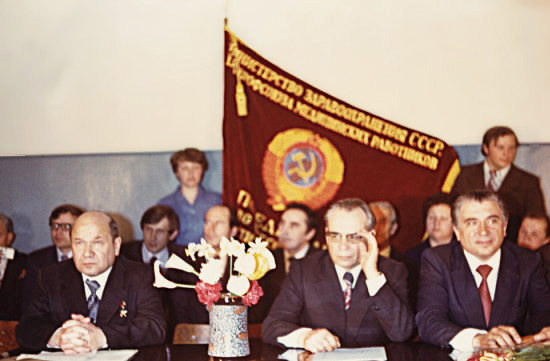
~ 1976 ~
The automated system of information processing (ASIP) developed at the Institute in 1970s (L. Ya. Shuster, Z. M. Gutman, A. E. Okeanov) played a great role in establishing control over the state cancer care for the population, activities of the oncological institutions and the efficiency of the anticancer measures taken. The USSR Public Health Ministry recommended by its special Order of December 3, 1976 that the ASIP be adopted in the practice of cancer institutions in all the Republics of the Union.
~ 1977 ~
In 1977 the RI OMR was one of the first among the research institutions of the Republic, going over to program-targeted planning of studies for the issue “Oncology Problem” with wide co-operation with scientists from academic organizations and scientific institutions of other departments in the Republic and the Union. To co-ordinate the activities on this most important issue, the Interdepartmental Co-ordination Council was established, chaired by N. N. Alexandrov, and the Oncology Institute was designated as the leading institution.
The end of the 1970s and the beginning of 1980s demonstrated the rise of the Institute’s prestige in the international oncologic community. With active N. N. Alexandrov’s participation, the program of collaborative studies with socialist community countries and USA oncologists was developed, with the aim of establishing a specialized cancer service.
The collaborative studies resulted in publishing the monograph “Cancer Control in the Member Countries of the Council for Mutual Economic Aid” in Russian and English.

At the reception hosted by R. Nickson, President of the USA (1978)
The Institute’s staff workers repeatedly made scientific reports at many forms both in the USSR and abroad. The 3d All-Union Conference on chemotherapy for malignant neoplasms held in Minsk in 1977 and the Co-ordination Meeting of the World Health Organization on cancer incidence registration and reporting held in 1978, both of them splendidly conducted, became a manifestation of the staff’s professionalism.
The Institute was repeatedly awarded prizes by the USSR and the BSSR Public Health Ministries, diplomas and medals by the USSR Exhibition of National Economic Achievements.
~ 1982 ~
The Institute’s fundamental traditions established by N. N. Alexandrov continued to be developed by his succesors. Since 1982, the directors of N. N. Alexandrov National Cancer Centre were Igor Grigoryevich Zhakov (1982-1990), Evgeni Alexandrovich Korotkevich (1991-200), Iosif Viktorovich Zalutsky (2000-2009), Arkadi Ivanovich Larionov (2009-2010), Oleg Grigoryevich Sukonko (since October 2010 and to this day).
~ 1983 ~
In 1983 the construction of the Institute’s new building was finished. This made it possible to expand the clinic up to 900 beds and to create a potential for its further specialization. The Institute’s framework included the divisions of pediatric oncology, intensive therapy, urologic oncology, contact radiotherapy.
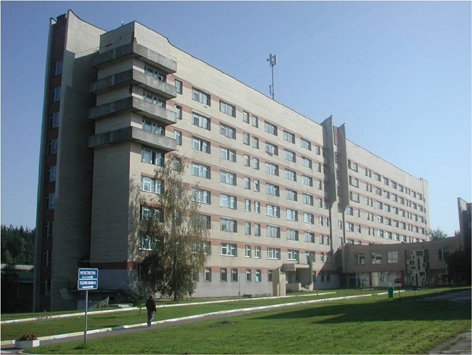
~ 1986 ~
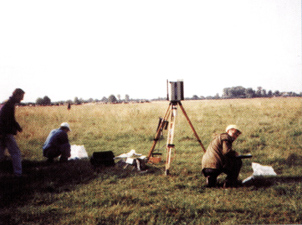 In 1986 the Institute actively participated in the liquidation of the Chernobyl Nuclear Power Plant accident. Evaluation of the radiation situation was made in the most affected regions of the Republic.
In 1986 the Institute actively participated in the liquidation of the Chernobyl Nuclear Power Plant accident. Evaluation of the radiation situation was made in the most affected regions of the Republic.
Thousands of people underwent radiologic monitoring, many of them were examined and treated at the Institute’s clinical divisions. To study the accident aftermaths at the chromosome level, cytogenetics laboratory was organized (S. A. Petrova, T. M. Kudina). A number of the Institute’s staff workers (I. G. Zhakov, I. G. Tarutin, M. K. Brekeshev) were conferred governmental awards.
This basic leads of research (prevention, diagnosis and treatment of cancers) were continued. Intensive methods were used to establish the system of criteria for retrospective prognosis of the clinical malignancy course (V. V. Zharkov).
The development of original radiotherapy techniques and mathematical radiation treatment programs, including those used with medical accelerators of new generations, the production of the antioxidant complex, a non-toxic modifier of chemoradio reactions, allowed to considerably enhance the role of radio- and chemotherapy in the management of cancer patients.
The Institute’s staff workers E. E. Vishnevskaya, I. G. Tarutin, N. I. Krutilina, V. N. Sukolinsky, T. S. Morozkina, G. V. Muravskaya were awarded the State Prize of the Republic of Belarus for the cycle of works “Addressing the issue of improving the efficacy of cancer patient treatment by development and introduction of new radiotherapy techniques into the clinical practice”.
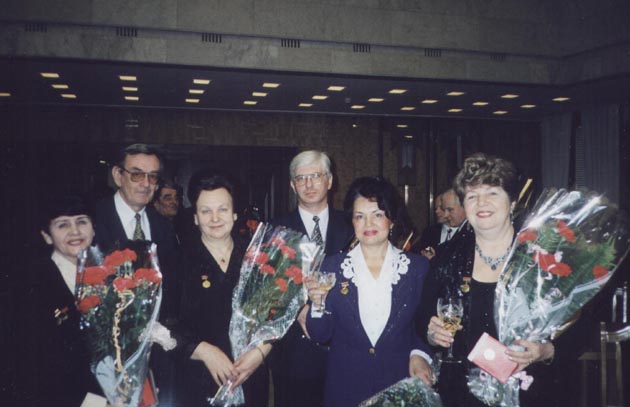
~ 1988 ~
In 1988 a group of the Institute’s specialists (N. N. Alexandrov, S. Z. Fradkin, E. A. Zhavrid, I. G. Zhakov, V. I. Bezruchko, Yu. P. Istomin, I. I. Malinovsky, T. V. Khodina, N. E. Savchenko) were awarded the BSSR State Prize for the cycle of works “The development and introduction of treatment modalities for malignant tumors using hyperthermia and hyperglycemia into practice”.
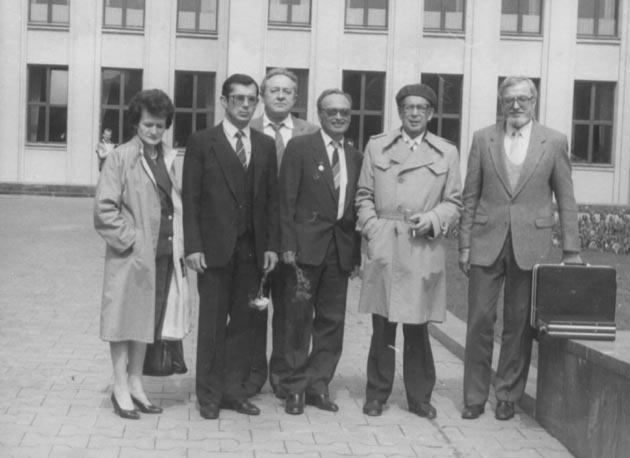
From the very first days of Institute’s existence, the traditional trend of its research was the development of scientific fundamentals for cancer control and prevention.
The long-term work of the mobile station for early cancer diagnosis and prevention, one of the first in the USSR, made it possible to design the basic principles of enhancing the efficacy of the oncological component in preventive examinations of the population (E. E. Skoblya, V. Ya. Zhukov).
~ 1990 ~
Further advance in the new scientific and practical trends (contact radiotherapy, pediatric oncology, urologic oncology, medical rehabilitation of patients, intensive chemotherapy, neurooncology) was made in 1990s.
The results of clinical testing of the home-produced chlorin e6 photosensitizer (E. A. Zhavrid, Yu. P. Istomin) laid the foundations for further application of photodynamic therapy and diagnostics in oncology.
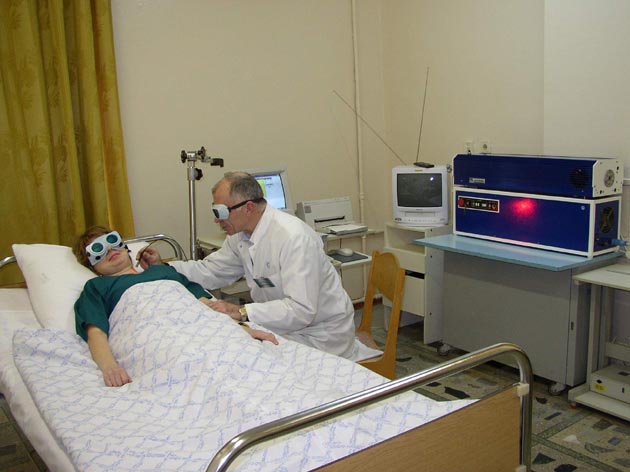
The Institute became the leader in the former Soviet Union in the development of the issue of plastic and reconstructive surgery in oncology. The initial phase of plastic surgery in national oncology, yet dating from 60-70s of the past century (M. I. Kovalev, N. A. Tishchenko) was successfully continued two decades later, also due to the introduction of microsurgery techniques (I. V. Zalutsky).
In 1992, The Council for the defence of doctor’s and master’s theses in oncology, diagnostic radiology and radiotherapy was organized at the Institute.
In the work of Urologic Oncology Department in 1990s, priority was given to investigation of new methods of intensive treatment for renal cancer patients, including prognostication of treatment outcomes. The novel techniques of combined application of radiotherapy and embolization of renal vessels in the preoperative period, as well as the use of whole-body hyperthermia and hyperglycemia in combination with chemotherapy made it possible to significantly improve the treatment efficacy (O. G. Sukonko, A. S. Mavrichev, S. A. Krasny, S. L. Polyakov).
The above-mentioned approaches had no foreign analogues!
In the subsequent years, endoscopic transuretral and laparoscopic interventions, radical prostatectomies and cystectomies with pelvic nerve plexus preseration, plastic surgeries with formation of a new urinary bladder from the bowels, operations using surgical laser and others introduced into practice became the achievements of urologic oncology.
The efficient utilization of new technologies resulted in the establishment of the first national automated system of scientific information in the field of oncology at the Institute. In 1996 a telecommunication unit was set up, forming the basis for successful development of the medical scientific information network of Public Health Ministry of Belarus, integrating more than 50 medical organizations (V. E. Kratenok , V.M. Nozik)
~ 1997 ~
In 1997 the Cancer Centre was named after its founder, and in 2010 the main street of the Zelyony Bor residental settlement, Minsk Region, was named after N.N. Alexandrov.
~ 2001 ~
In May 2001, Alexander Grigoryevich Lukashenko, President of the Republic of Belarus, visited the Institute. The President`s visit gave a new impetus to the process of material and technical re-equipment of the Institute and intensification of scientific studies.
During this period, new Institute buildings (the buildings for pathomorphology and laboratory services) were commissioned, and the old ones were modernized.
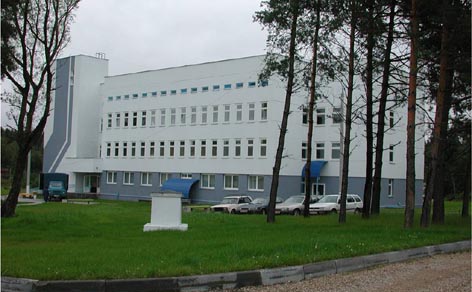
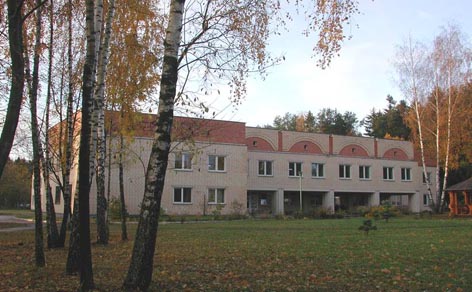
Up-to-date diagnosis and treatment facilities were purchased and put to use, including the system for megavoltage radiotherapy. The reconstruction and major repairs of the operation-and-resuscitation building were completed with full re-equipment of operating theatres and resuscitation wards.
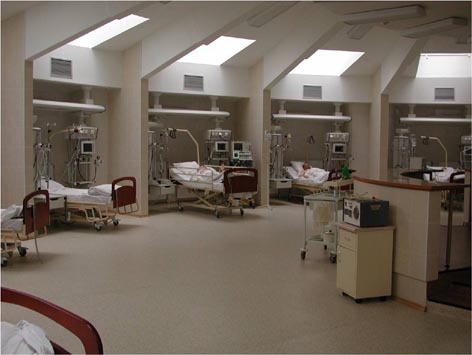
Video-assisted operating rooms were provided for, making it possible to introduce high-tech medical interventions. Alongside extended and combined operations, hypoinvasive radiosurgical and videoscopic operative interventions were introduced into the practice of clinical trials.
In the field of radiotherapy, the research was first of all focused on warranting quality assurance for this kind of treatment, its individualization, delivering the maximal radiation dose to the tumor with minimal damage of the normal tissue, 3D imaging is issued for treatment planning. New techniques of stereotaxic radiotherapy, brachy- and endovascular therapy were introduced
The research activities in the field of tumor chemotherapy were concentrated on the development and introduction of new treatment regimens for malignancies into the clinical practice, on the search for molecular biochemical markers for prognostication of antitumor therapy efficacy, on working out national standards of chemotherapy for malignant neoplasms, etc.
A group of the Institute`s specialists in the field of cancer epidemiology is consistently engaged in monitoring and prognostication of cancer incidence in the population of the Republic of Belarus, and also in studying the oncology component in the aftermaths of the Chernobyl Nuclear Power Plant accident.
~ 2004 ~
In May 2004, the III Congress of oncologists and radiologists from the CIS countries was held at N.N. Alexandrov RI OMR, confirming the demands for the accomplishments of Belarusian oncology scientists abroad.
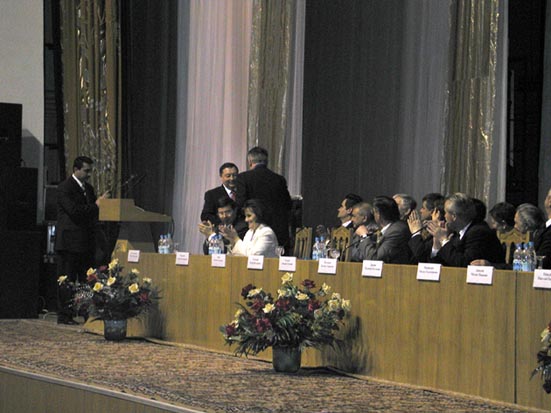
The Edict issued by A.G. Lukashenko, President of the Republic of Belarus, on July 6, 2005 included oncology in the framework of priority leads in science-and-technology activities in the Republic of Belarus for 2006-2010.
~ 2007 ~
In December 2007 the Institute was renamed as National Science-and Practice Centre of Oncology and Medical Radiology (N.N. Alexandrov National Cancer Centre (NCC)). In June 2008, N.N. Alexandrov NCC was awarded the Honorary Diploma of the Council of Ministers of the Republic of Belarus for considerable scientific and practical contribution to the national oncology, development and introduction of medical technologies and methods of diagnosis and treatment of tumors, training of skilled medical personnel.
~ 2010 ~
In 2010 N.N. Alexandrov National Cancer Centre, Health Ministry of the Republic of Belarus, celebrated its 50th anniversary.
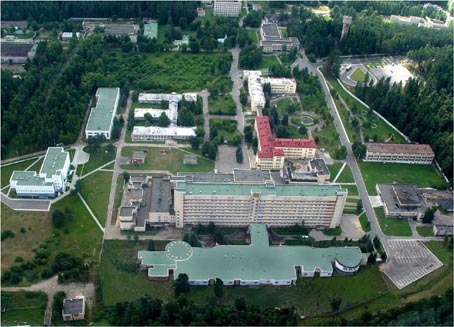
Over those years, a long distance was passed from several premises at the former National Cancer Dispensary to the great complex of clinical, experimental and productive buildings with a residential settlement for the Centres’ staff workers.
~ 2011 ~
The staff of the Cancer Centre (2011)
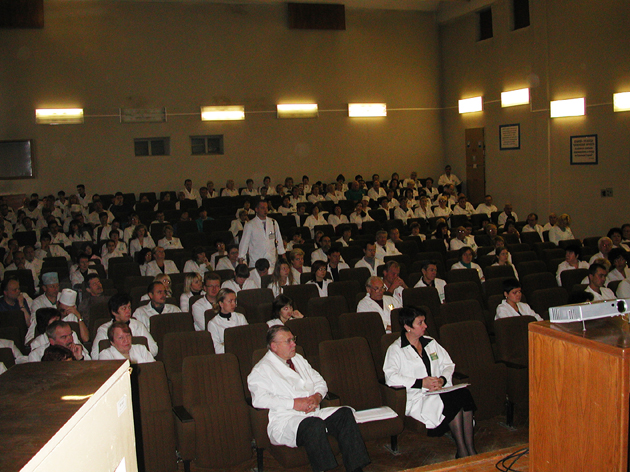
~ 2017 ~
At present, the Centre is an integral research, treatment and training complex. The Centre’s frame work includes 42 treatment-and-diagnosis divisions, the department of extra-budget activities and the research sector comprising 3 departments and 6 laboratories. The Centre employs 1948 staff workers, among them 412 doctors, including 19 DScs and 77 MScs (Medicine and Biology), 11 professors, 10 assistant professors, one corresponding member of the National Academy of Sciences, Belarus; 163 doctors have the highest qualification grade.
The personnel of the highest scientific grade is trained for the specialities 14.01.12 – oncology and 14.01.13 – diagnostic radiology, radiotherapy in postgraduate and doctoral studies.
Last year the Centre received a special permission (licence) of the Education Ministry of the Republic of Belarus No 02100/565 entitling to carry out educational activities. A resource Centre is scheduled to be established, its employees, supposed to do the training.
The Centre is the largest medical research institution in the Republic of Belarus.
Scientific activities:
- Organization of cancer control, investigation of cancer epidemiology and prevention.
- Designing of screening programs and new technologies for diagnosis of malignant tumors.
- Designing of new technologies for treatment of cancer patients.
- Designing of new technologies for rehabilitation and improvement of cancer patient life quality.
- Updating the medicotechnical basis of the country`s cancer service.
The Centre annually publishes about 200 scientific papers based on the research done. The peer-reviewed Oncological Journal is published, its founder being the public organization “Belarusian Society of Oncologists”.
The Oncology Chair of the Belarusian Medical Academy for Postgraduate Training and the Council for Theses Defence in oncology, diagnostic radiology and radiotherapy specialities function on the basis of the Centre.
Medical services:
N. N. Alexandrov NCC provides the whole range of medical services in cancer diagnosis and treatment in the following basic fields: gynecologic oncology, urologic oncology, head and neck tumors, mammologic oncology, neurooncology and vertebrology, gastrointestinal, hepatic, biliary duct and pancreas, thoracic tumors. The Department od Anesthesiology and Resuscitation is equipped with up-to-date facilities for monitoring and life-support.
- The Centre’s specialists master the most efficient modalities of surgery, radiation treatment and chemotherapy for all types and sites of malignant tumors, used in the global practice.
- Video-assisted, plastic, reconstructive, organ-sparing and simultaneous operations are widely used. The referral of cancer patients for treatment and examination abroad is actually completely excluded.
- The Centre has designed and put to use unique methods of diagnosis and treatment employing original Belarusian drugs (5-aminolevulinic acid, Photolon) having no analogues in the CIS countries and the world over, such as hyperthermia for advanced cancers, photodynamic therapy for female genital precancers.
- The Centre has set a system of providing outpatient medical care (chemotherapy, surgery, radiotherapy).
To raise the level of specialized counselling availability, to improve the conditions of patient servicing, to expand the scope of hospital-substituting technologies, on December 28, 2016 the newly constructed (consultative Outpatient Department equipped with modern facilities and intended for 800 visits per day was inaugurated).
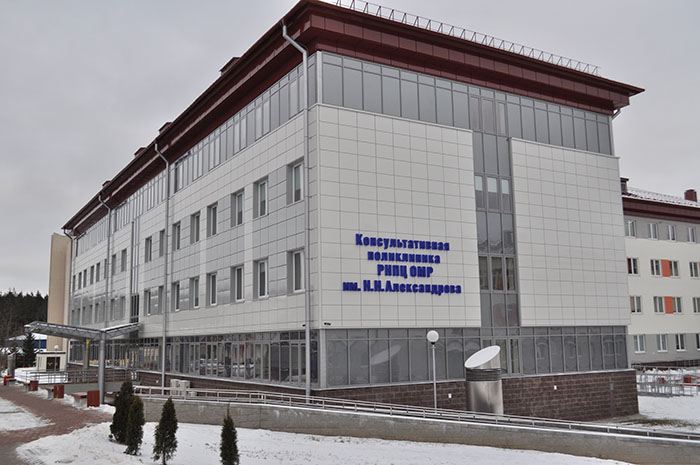
The potential for performing drug therapy is going to be significantly increased. For this purpose, a 25-bed outpatient chemotherapy unit disposing of two- and three-bed wards was established.
Putting the hypoinvasive surgery division into commission will significantly widen the range of diagnostic and surgical outpatient interventions performed on three operating tables.
The Centre’s diagnostic services are equipped with modern facilities making it possible to establish the diagnosis in the most complicated cases at the earliest possible date.
Laboratory diagnostics
The whole range of biochemical, clinical, morphological, immunohistochemical, molecular genetic tests, the study of tumor markers of hereditary breast, ovarian, colon cancers.
Diagnostic radiology: The complete range of standard X-ray imaging, computed tomography, magnetic resonance imaging, digital mammography, angiography, ultrasonography, radionuclide evaluation, positron emission tomography.
Endoscopic examinations: gastroduodenoscopy, bronchoscopy, cystoscopy, laparoscopy, mediastinoscopy, thoracoscopy, colposcopy.
The new diagnostics subunits (the National Molecular Genetic Laboratory of Carcinogenesis and the Centre of Positron Emission Tomography) commissioned in 2015 brought up tumor diagnosis, monitoring and individualization of chemotherapy for malignant tumors to a qualitatively new, economically substantiated level; it allowed to organize conducting of up-to-date fundamental and applied scientific research on their basis; personification of treatment strategy was ensured.
Molecular tumor profiling (creation of the genetic “picture”) contemplates the detection of genetic disorders inherent for each specific tumor, aiming to predict the cancer course and to select tailor-made regimens of systemic antitumor therapy. The definition of molecular biomarkers of sensitivity and toxicity enables to most efficiently address the issue of selecting patient treatment schemes with regard to the individual peculiar features of the body and the tumor course.
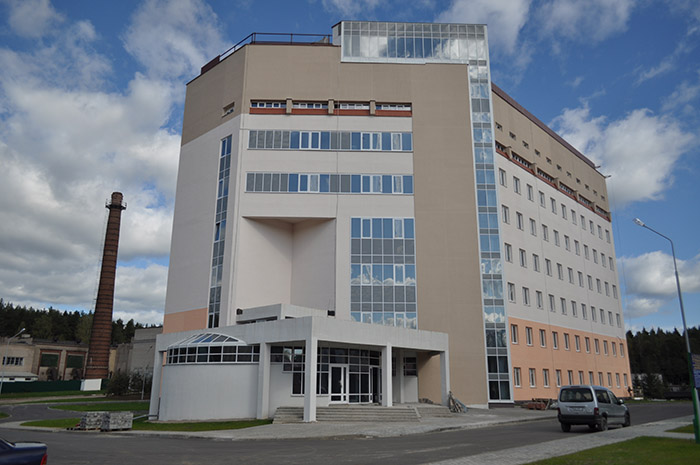
The treatment of a number of malignant tumors and evaluation of its efficacy are currently impossible without positron emission tomography, as this procedure ensures the precise choice of adequate treatment and its correction for each patient.
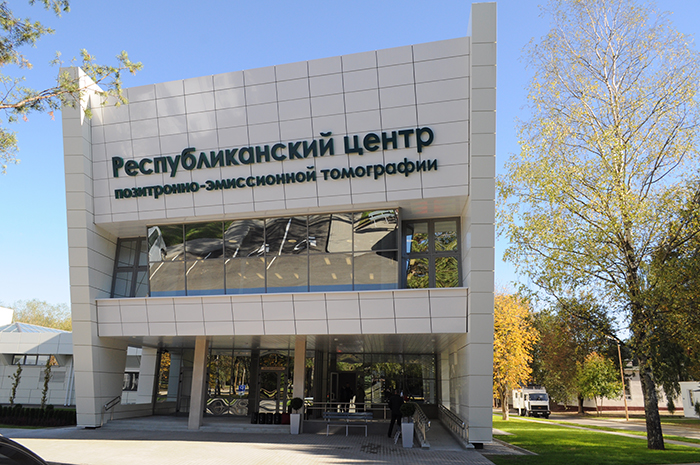
The cyclotron radiochemistry laboratory of the PET Centre is equipped with an accelerator (cyclotron) intended for the production of home-made radiotracers used in radioisotope scintigraphy of tumors sizing 2mm and more in diameter, and in determining their viability.
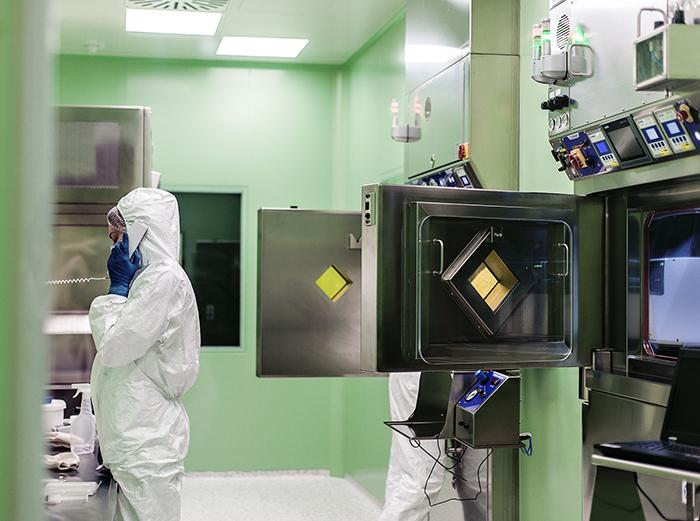
On October 7, 2015, the inauguration of the National Centre of Positron Emission Tomography (PET Centre) was participated by A. G. Lukashenko, President of the Republic of Belarus. The President got acquainted with the activities of the National Molecular Genetic Laboratory of Carcinogenesis and met with the participants of the scientific and practical conference “New Technologies in Medicine”. A.G. Lukashenko noted that the introduction of essentially new approaches to diagnosis and treatment of malignant diseases should be continued in the country.
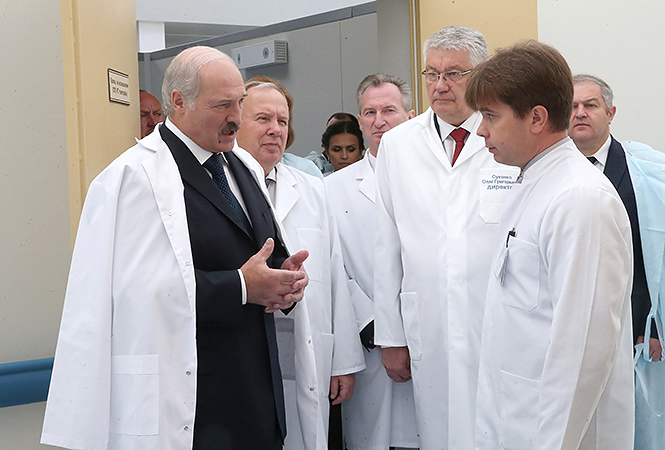
Over the past 5 years, the number of patients undergoing surgery in the Centre was increasing, and so was the number of their operations (from 11108 in 2012 to 11578 in 2016, a 4.1% growth).
An increase is observed in the proportion of high-tech and intricate surgeries performed by highest and first-grade doctors trained in cancer clinics and centres of other countries.
In 2016, 1461 high-tech surgical interventions were performed, that is 1.8-fold more than in 2012 (801).
Owing to the highly skilled personnel, update of surgical apparatus and instruments, improvement of anesthesiologic support, the operations considered impracticable or unique 10 years ago are now daily routine:
- Reconstructive and plastic surgery for tumors of larynx, urinary bladder, esophagus, extremities, breast and other sites with restoration of the lost functions.
- Simultaneous and combined surgery with resection of vital organs and structures (spine, heart, great vessels, liver, etc).
- Extracorporal resection of organs with subsequent autotransplantation (kidney, lung and heart).
In 2016 the transplantation of tissue-engineering respiratory tracts involved by tumorous or scarry tissue was mastered.
Over the past 10 years, the number of patients requiring inpatient urologic cancer care increased more than 2-fold (from 1003 to 2126 patients). The number of inpatient surgeries grew too (from 864 to 1765).
The overhaul with complete technical reequipment of the Urologic Oncology Department, terminated in December 2016, made it possible to provide up-to-date high-tech urologic cancer care.
The extended scope of surgeries performed, active introduction of endovideosurgical interventions for the treatment of urologic cancer patients not only from this country but also from abroad creates prerequisites for further expansion of medical services export.
Scientific and technical progress has also applied to radiotherapy techniques and facilities. The equipment installed allows to perform radiation treatment employing high-tech techniques (IMRT, VMAT), their proportion being more than 50%. 3D planning, stereotaxic surgery and therapy enable to deliver the maximally possible radiation dose to the tumor, with minimal radiation exposure of the adjacent normal tissues.
In 2016, about 2500 were treated on linear accelerators.
Besides the three linear accelerators available in the Centre, in 2016 the specialized TrueBeamRTx linear accelerator for stereotaxic radiation treatment, and the specialized GammaKnife Perfection radiosurgical system were purchased, making it possible to provide great-precision radiotherapy at the up-to-date level.
Contact radiotherapy (brachytherapy) is conducted using four brachytherapeutic systems.
The most modern regimens of chemotherapy are adopted, employing targeted agents. The full range of cancer-specific drugs is available in the Centre. They are supplied due date by the National Unitary Belpharmacy Company.
To make efficient use of and to correctly prescribe the medications, a station for centralized drug dilution was organized, and the position of clinical pharmacologist was introduced at the Centre.
Electronic medical documentation
Intense activities are undertaken to adapt and introduce electronic medical documentation (outpatient card and case history), based on AIC MEDiK Dispensary software, in all clinicodiagnostic and therapeutic divisions. Updating of the Belarusian Cancer Registry facilitated classification of the data and improvement of quality of medical care provision with regard to timely acquiring patient information.
Prevention
The prevention trend has been and is one of the topical issues governing the NCC activities. The screening strategy for tumors of certain sites is being intensely developed producing an appreciable beneficial effect right now, a large number of small tumors being detected. Indeed, prostate cancer screening commenced in 2011 made it possible to increase 9.6-fold the detection of this abnormality and to reduce 2.5-fold the number of far-advanced cancers; mammography screening of breast cancer in 2012 improved the diagnosis of stage 0 and I breast cancer 2-fold.
The IX Congress of oncologists and radiologists from the CIS and Eurasia
In June 2016, the IX Congress of oncologists and radiologists from the CIS and Eurasia was held in Minsk, participated by more than 2500 delegates from 19 countries. The accomplishments of Belarus’ cancer service, the most successful in Eastern Europe, were noted in the Congress resolution draft.
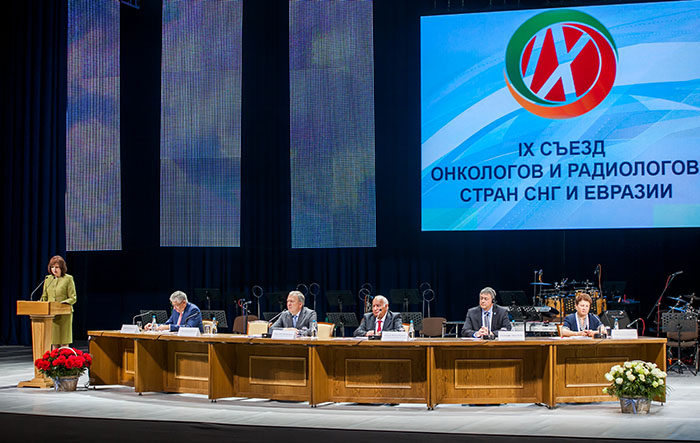
The experience in cancer care provision based on advanced national and global designs is presented in the two-volume Manual in Oncology edited by Prof. O. G. Sukonko, MD DSc; the Manual has no analogues on the territory of the former Soviet Union.
The Manual sets forth current data on prevention, diagnosis and treatment of malignant tumors and cancer patient rehabilitation. Moreover, the historical aspects of oncology development in Belarus are offered.
The well thought-out framework, the modern clinical basis, the research designs make N. N. Alexandrov NCC a unique in all respects scientific and practical institution whose activities are targeted at adequate control of malignant neoplasms.
The essential wealth of N. N. Alexandrov National Cancer Centre is its well-coordinated team of like-minded persons, skilled professionals, their common everyday labour pursueing the principal objective of successful control of malignant neoplasms.
Compiled by S. A. Petrova, MD MSc, Manager of N. N. Alexandrov NCC History Museum.





